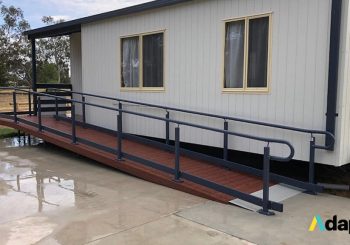Creating an inclusive society requires the collective efforts of individuals from all walks of life. Building spaces that are accessible to everyone is a shared responsibility.
With accessible entrances, people with disabilities can enjoy services and participate fully in their communities. Modular ramps offer a flexible and adaptable solution to address specific accessibility needs and space limitations. They provide crucial access and support for individuals facing mobility and disability challenges, as well as older adults and young children. To ensure their effectiveness, it is essential to design modular ramps with considerations for grip, traction, measurements, and materials that meet accessibility safety standards. By adhering to these standards, modular ramps can effectively enhance accessibility and enable individuals to navigate spaces with ease and independence.
Here are five best practices to consider when designing accessible entrances:
Safety Handrails
Safety handrails play a vital role in enhancing accessibility and mobility for individuals. By installing sturdy handrails along ramps and steps, additional support is provided, allowing individuals to have something to hold onto while moving. This not only increases comfort and confidence but also promotes independence.
For people with disabilities, the ability to navigate spaces independently, without relying on caregivers or loved ones, fosters a sense of empowerment and self-reliance. Safety handrails are an essential feature in creating inclusive environments that prioritise the well-being and autonomy of all individuals. To learn more about how handrails can help improve a space, visit this post.
Automatic doors
Public spaces should have accessible entrances with sufficient width to accommodate wheelchairs and individuals using crutches. These entrances should also include markers that provide support for the visually impaired. Automatic doors eliminate physical barriers and facilitate easy entry and exit. Equipped with motion sensors or push buttons, they allow individuals using mobility aids to navigate doorways independently.
Accessible elevators
Accessible elevators play a pivotal role in promoting mobility and inclusivity within multi-level buildings. Designed with wider doors, they provide easy access for individuals using mobility aids like wheelchairs. The spacious interiors also allow for maneuverability, ensuring comfortable movement, as well as controls that are positioned at accessible heights, empowering individuals with disabilities to operate the elevators independently.
Accessible signage
Clear and visible signage is crucial for providing information to individuals. Accessible door signages incorporate visual symbols, braille, and high-contrast colours to assist those with visual impairments or cognitive disabilities. Well-designed signages enable individuals to confidently identify and locate accessible entrances, exits, and facilities within buildings, promoting independence and comfort.
Removing Physical Barriers
Implementing these best practices for accessible entrances is a crucial step towards achieving equal access and opportunities for individuals of all abilities. By removing physical barriers and incorporating features like modular ramps, safety handrails, automatic doors, accessible elevators, and clear signage, we can create an environment that fosters inclusivity and empowers individuals to fully engage in society.
It is essential to recognise that accessibility is an ongoing process. Keeping up with the latest guidelines and regulations ensures that our design choices align with the evolving needs of diverse individuals. By staying informed and continuously striving for improvement, everyone can help in creating truly inclusive spaces.



